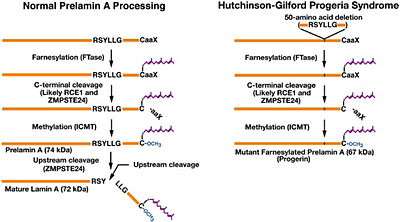Progerin
Progerin (P02545-6) is a truncated version of the lamin A protein involved in the pathology of Hutchinson–Gilford progeria syndrome. Progerin is most often generated by a single nucleotide polymorphism (C1824T) in the gene that codes for Lamin A. This mutation activates a cryptic splice site and gives rise to a form of lamin A with a deletion of 50 amino acids near the C-terminus.[1] Approximately 80% of all Hutchinson–Gilford progeria syndrome cases are heterozygous for this deleterious single nucleotide polymorphism within exon 11 of the LMNA gene.[2]

Lamin A constitutes a major structural component of the lamina, a scaffold of proteins found inside the nuclear membrane of a cell; progerin does not properly integrate into the lamina, which disrupts the scaffold structure and leads to significant disfigurement of the nucleus, characterized by a lobular shape.[3] Progerin activates genes that regulate stem cell differentiation via the Notch signaling pathway.[4] Progerin increases the frequency of unrepaired double-strand breaks in DNA following exposure to ionizing radiation.[5] This finding suggests that the nuclear lamina has an important role in the repair of DNA double-strand breaks.[5]
Researchers are exploring lonafarnib (a farnesyltransferase inhibitor) as a potential pharmacological therapy against the negative effects of progerin on nuclear morphology in HGPS.[3]
Recently, rapamycin has been shown to prevent progerin aggregates in cells and hence delay premature aging.
Progerin, which has been linked to normal aging, is produced in healthy individuals via "sporadic use of the cryptic splice site".[4][6]
References
- Eriksson M, Brown WT, Gordon LB, et al. (May 2003). "Recurrent de novo point mutations in lamin A cause Hutchinson–Gilford progeria syndrome" (PDF). Nature. 423 (6937): 293–8. doi:10.1038/nature01629. PMID 12714972.
- McClintock D, Gordon LB, Djabali K (February 2006). "Hutchinson–Gilford progeria mutant lamin A primarily targets human vascular cells as detected by an anti-Lamin A G608G antibody". Proc. Natl. Acad. Sci. U.S.A. 103 (7): 2154–9. doi:10.1073/pnas.0511133103. PMC 1413759. PMID 16461887.
- "Anti-cancer Drugs May Hold Promise For Premature Aging Disorder". Retrieved 2008-07-15.
- Scaffidi P, Misteli T (April 2008). "Lamin A-dependent misregulation of adult stem cells associated with accelerated ageing". Nat. Cell Biol. 10 (4): 452–9. doi:10.1038/ncb1708. PMC 2396576. PMID 18311132.
"Adult stem cell changes underlie rare genetic disease associated with accelerated aging". Retrieved 2008-07-15. - Noda A, Mishima S, Hirai Y, Hamasaki K, Landes RD, Mitani H, Haga K, Kiyono T, Nakamura N, Kodama Y (2015). "Progerin, the protein responsible for the Hutchinson-Gilford progeria syndrome, increases the unrepaired DNA damages following exposure to ionizing radiation". Genes Environ. 37: 13. doi:10.1186/s41021-015-0018-4. PMC 4917958. PMID 27350809.
- Liu B, Zhou Z (June 2008). "Lamin A/C, laminopathies and premature ageing". Histol. Histopathol. 23 (6): 747–63. PMID 18366013.